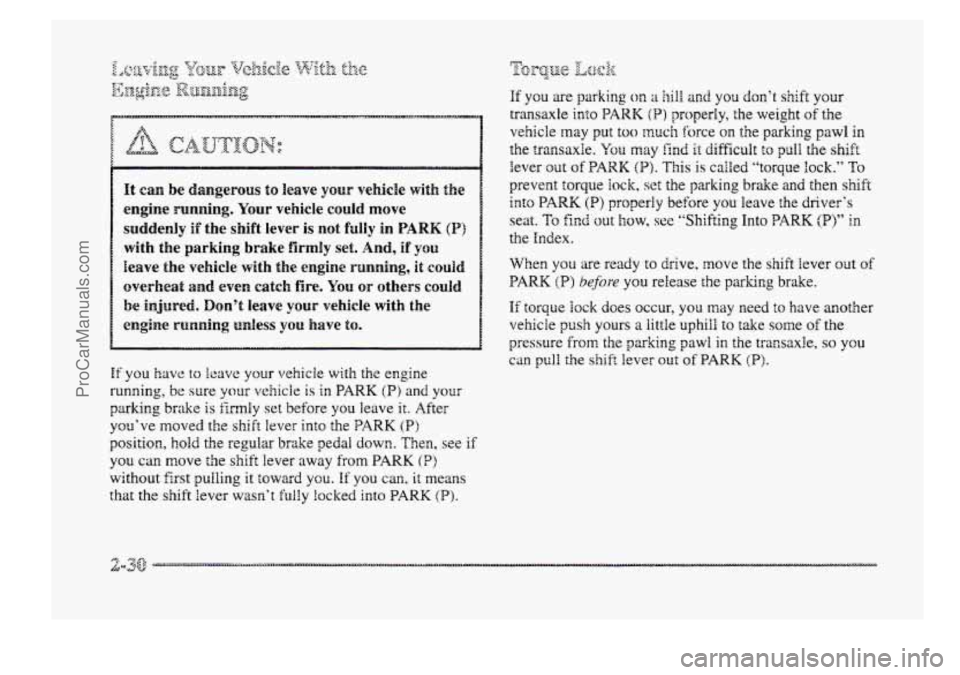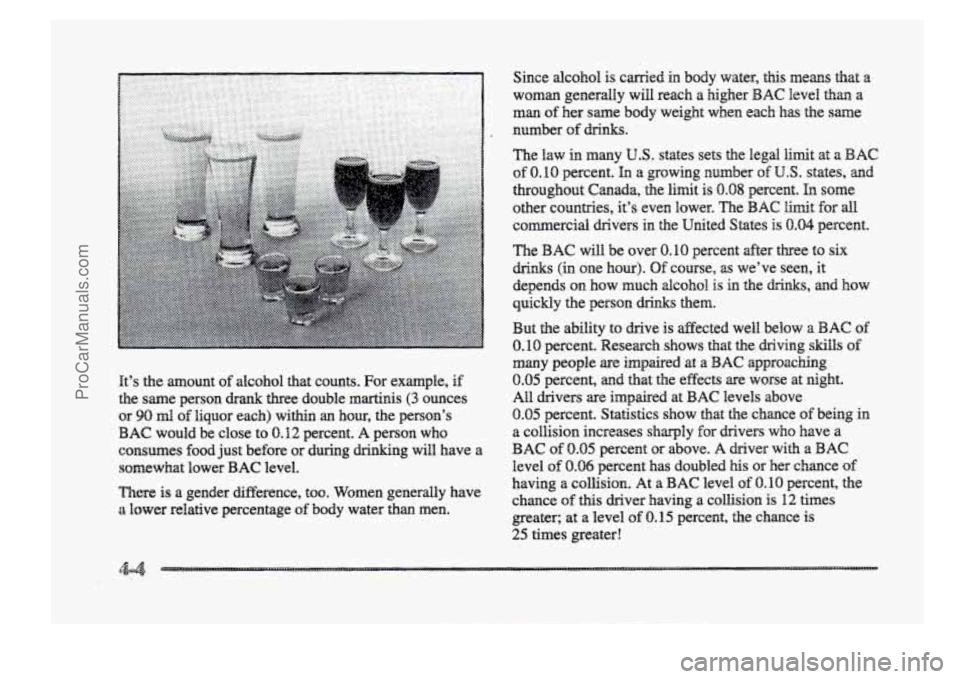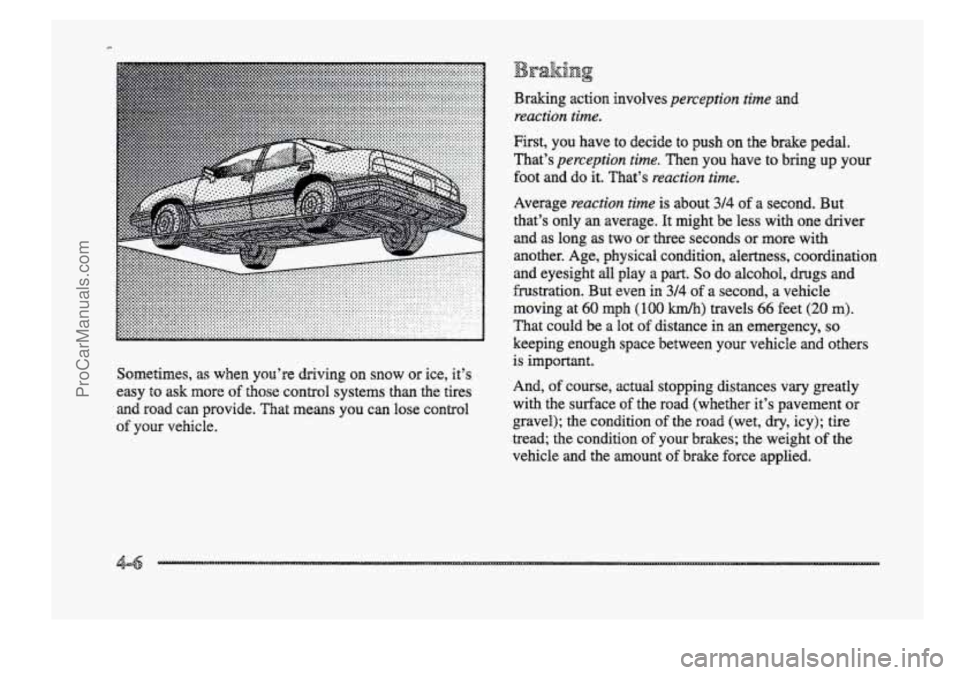Page 49 of 426
A: Add-on child restraints are available in four
basic types. When selecting a child restraint,
take int~ consideration not only the child’s weight
and size, but dso whether or not the restraint will
be compatible with the motor vehicle in which it
will be used.
An infant car bed (A) is a specid bed made for use
in a motor vehicle. It’s an infant restraint system
designed
to restrain or position a child on a
continuous flat surface. With an idat car bed,
make sure that the infant’s head rests toward the
center of the vehicle.
ProCarManuals.com
Page 96 of 426

~ It can be dangerous to leave YQW vehicle with the
~ engine running. Your vehicle could move
i suddenly if the
shift lever is not hlPy in PARK (P)
with the parking brake firmly set. And, if you
leave the vehicle with the engine running, it couk.€
overheat and even catch fire. YQU or others could
be injured. Don’t leave YOUK- vehicle with the
engine running unless you have to.
I
Hf you have to leave your vehicle with the engine
running, be sure your vehick is in PARK (P) and your
parking brake is firmly set before you Ieave it. After
you’ve moved the shift lever into the ?ARK (P)
position, hold the regular brake pedal down. Then, see if
YOU can move the shift lever away from PARK (?)
without first pulling it toward you. If you can, it means
that the shift lever wasn’t fully locked into PARK (P).
r-m naqae Le!#& I
If you are parking on ;I hill and you don’t shift your
transaxle into PAKM (P) properly, the weight of the
vehicle may put too rntich force OD the parking pawl in
the transaxle. You may f’ind it difficult to pull the shift
lever out of PARK (P). This is called “torque lock.” To
prevent torque lock, set the parking brake and then shift
into PARK (P) pr~perfy before you leave the driver’s
seat.
TQ find out how, see “Shifting Into PARK (P)” in
the Index.
When you are ready to drive, move the shift lever out of
PARK (P) bejbre YOU retease the parking brake.
If torque lock does occur, you may need to have another
vehicle
push yours a little uphill to take some of the
pressure from the pxking pawl in the tramaxle, so you
can pull, the shiR lever out of PARK (P).
ProCarManuals.com
Page 206 of 426

It’s the amount of alcohol that counts. For example, if
the same person
drank thee double martinis (3 ounces
or
540 d of liquor each) within an hour, the person’s
BAC would be close to 0.12 percent. A person who
consumes food just before
or during drinking will have a
somewhat Bower
BAC level.
There is a gender difference, too. Women generally have
a Bower relative percentage of body water than men. Since alcohol
is carried in body water, this means that a
WQ~ZUI generally will reach
a higher BAC level than a
man of her
same body weight when each has the same
number of
chinks.
The law in many U.S. states sets the legal limit at a BAC
of 0.10 percent. Hn a growing number of U.S. states, and
throughout Canada, she limit is 64.08 percent. Ina some
other countries, it’s even Bower. The
BAC limit for all
commercial drivers in the United States is 8.04 percent.
The
BAC will be over 0.10 percent after three to six
drinks (in one hour). Of course, as we’ve seen, it
depends
on how much alcohol is in the drinks, and how
quickly the person drinks them.
But the ability to drive is affected well below a BAC of
0.10 percent. Research shows
that the driving skills of
many people are impaired at a BAC approaching
0.05 percent,
and that the effects are worse at night.
All drivers
are impaired at BAC levels above
0.05 percent. Statistics show that the chance of being in
a collision increases sharply for drivers who have a
BAC of 0.05 percent or above. A driver with a BAC
level of 0.06 percent has doubled his or her chance of
having a CO~~S~OIL At a BAC level of 0.10 percent, the
chance
of this driver having a collision is 12 times
greater;
at a level of 0.15 percent, the chance is
25 times greater!
ProCarManuals.com
Page 208 of 426

Sometimes, as when you’re driving on snow or ice, it’s
easy
to ask more of hose control systems than the tires
and road can provide.
That means you can lose control
of your vehicle. Braking
action involves perreption
time and
reaction time.
First, you have to decide to push on the brake pedal.
That’s
perception time. Then you have to bring up your
foot and do it. That’s reaction time.
Average reaction time is about 314 of a second. But
that’s
only an average. It might be less with one driver
and as long
as two OS three seconds or more with
another. Age, physical condition, alertness, coordination
and eyesight
dl play a part. So do alcohol, drugs and
frustration. But even
in 3/4 of a second, a vehicle
moving at
60 mpph (100 km/h) travels 66 feet (20 m).
That could be a lot of distance in an emergency, so
keeping enough space between your vehicle and others
is important.
And,
of course, actual stopping distances vary greatly
with the surface
of the road (whether it’s pavement or
gravel); the condition
of the road (wet, dry, icy); tire
tread; the condition
of your brakes; the weight of the
vehicle and the
amount of brake force applied.
ProCarManuals.com
Page 232 of 426
i
T!RE-LOADING tNFBRMAT!ON
OCCUPANTS VEHICLE CAP. WT.
FRT. CTR. RR. TOTAL LBS. KG
1 MAX. LOADING €9 GVWR SAME AS VEHICLE
i CAPACITY WEIGHT X>(>( COLD TIRE
TIRE SIZE SPEED PRESSURE
RTG PSI:KPa
IF TIRES ARE HOT, ADD 4PSIj28KPa
SEE OWNER'S MANUAL FOR ADDITIONAL
INFORMATION
Two labels on pur vehicle show how much weight it
may properly cmy. The Tire Loading Information label
found on the rea edge of the driver's door tells YOU the
groper size, speed rating and recommended inflation
pressures
for the tires on your vehicle. It also gives you
important infomation about the number of people that
can be in your vehicle and the total weight that you can
carry. This weight is called the Vehicle Capacity Weight
and includes the weight of all occupants, cargo, and all
nonfactory-instalM QP~~QP~S.
ProCarManuals.com
Page 233 of 426
MFD BY GENERAL MOTORS COWP
DATE GVWW GAWR FRT GAWR RW
The other label is the Certification Label. found on the
rear edge cf the driver's door. it tells ycu the gross
weight capacity of your vehicle, called the Gross
vehicle Weight Rating (GVW).The GVWR includes
the weight
of the vehicle, all occupants. fuel and cargo.
Never exceed the GWR for your vehicle, or the Gross
Axle Weight Rating (GAWR) foreither the front or
rear axle.
YOUr WEtE'ralI~y does COWX gSa€%S 03.
components that fail because of overloading.
Hf you put things inside your vehicle -- like suitcases,
tools, packages, or anything else -- they will go as fast
as the vehicle goes. If YOU have to stop or turn quickly,
or if there is a crash, they'll keep going.
ProCarManuals.com
Page 234 of 426
Your vehicie can tow a trailer if it is equipped with the
proper trailer towing equipment. To identify what the
vehicle trailering capacity is far your vehick, you
shora'rd read the infomation in "Weight of the Trailer"
that appears later in this section. But trailerifmg is
differect than just driving your vehicle by itself.
Trailering neans changes in handling, durability and
fuel economy. Successful, safe tmilering takes correct
equipment, and it has to be used properly.
4-32 . . I~
ProCarManuals.com
Page 235 of 426
Eszd-pulling components such as the engine, transaxle.
wheel assembiles and tires %e forced ea work harder
against the drag uf the added weight. The engine is
required to operate at reEativeIy higher speeds and gnder
grczter Isads, gecerating extra heat. What's more, the
trailer adds considerably to wid resistance, increasing
the pulling requirements.
If You Do Decide To PnlI A Railerr
If you do, here are some irqm-tana points:
There
are mmy different laws, inclndlng speed Zimit
restrictions, having to do with trailerkg Make sure
your
rig will be legal, not only where yolr live but
also where you'll be driving. A good source for this
infomation can be state or' provincial peke.
ProCarManuals.com